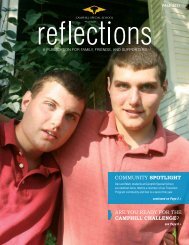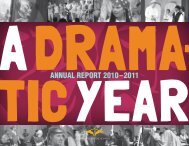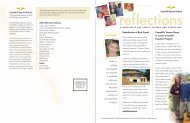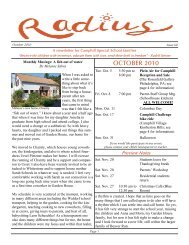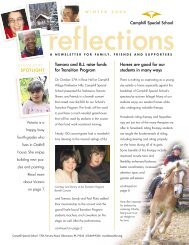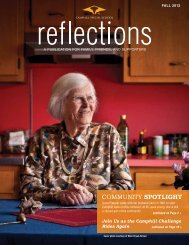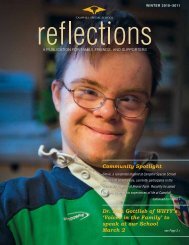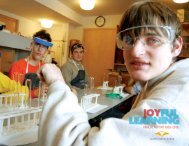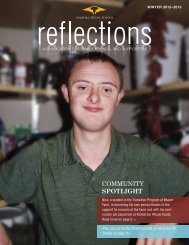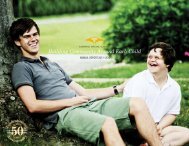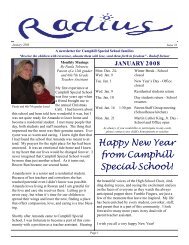CAMPHILL SPECIAL SCHOOL
CAMPHILL SPECIAL SCHOOL
CAMPHILL SPECIAL SCHOOL
You also want an ePaper? Increase the reach of your titles
YUMPU automatically turns print PDFs into web optimized ePapers that Google loves.
Camphill Special School consists of The Children’s<br />
Village and School at Beaver Run, The Transition<br />
Program at Beaver Hill and Beaver Farm, and<br />
The Camphill School of Curative Education.<br />
Our mission is to create wholeness for children and<br />
youth with developmental disabilities through education<br />
and therapy in extended family living. The Camphill<br />
School of Curative Education offers a four-year professional<br />
course of studies in anthroposophical curative<br />
education, the approach to working with children and<br />
youth with special needs that is practiced at Camphill<br />
Special School. Camphill Special School does not<br />
discriminate on the basis of race, age, color, creed,<br />
gender, sexual orientation, national or ethnic origin,<br />
or disability.<br />
<strong>CAMPHILL</strong> <strong>SPECIAL</strong> <strong>SCHOOL</strong><br />
2006–2007 Board of Directors<br />
Craig L. Adams, President<br />
Warren R. Gleicher, Esq., Vice President<br />
Jeffrey Powers, Treasurer<br />
Claus Sproll, Secretary<br />
Guy Alma<br />
Jan Christopher Goeschel<br />
William C. Herman, Esq.<br />
Ronald Landon<br />
Eliza Carlson Lee, Ph.D.<br />
Manfred Maier<br />
Richard Oswald<br />
Andreas Schad<br />
Bernard Wolf<br />
Emeriti<br />
Ursel Pietzner<br />
Raymond Ripper<br />
<strong>CAMPHILL</strong> <strong>SPECIAL</strong> <strong>SCHOOL</strong><br />
2006 – 2007 ANNUAL REPORT<br />
43 Years of Sharing Life<br />
and Sharing Learning<br />
1784 Fairview Road<br />
Glenmoore, PA 19343<br />
610.469.9236<br />
www.camphillspecialschool.org
What does it mean to arrive at middle age Our<br />
“forties” can be either a decade of crisis or years of<br />
tremendous fruitfulness. Middle age potentially is a time<br />
of maturity, capability, and a growing sense of purpose.<br />
After years of learning the ropes, figuring out who we<br />
are, and mentoring from our elders, we come to a time<br />
Less visible, but equally important, our Camphill School<br />
of Curative Education has matured into a full four-year<br />
Certification course with an optional BA degree completion<br />
component. This is our brightest hope for the<br />
expansion of our work, not only here in Glenmoore,<br />
but across North America.<br />
TABLE OF CONTENTS<br />
A message from the President 4<br />
Bernie’s poem: To Autumn Wake 5<br />
1972: Something wonderful might slip in 6<br />
2007: More beautiful than we imagined 7<br />
This Annual Report is dedicated with love to<br />
the memory of Theresa Katharine McCardell,<br />
who lived as an angel among us from<br />
of giving back.<br />
Camphill Special School turned forty-three in December<br />
Camphill Special School is forty-three years of proof that<br />
children with intellectual and developmental disabilities<br />
What does it mean to be a Waldorf School 8 – 9<br />
Transition Program eagerly looks to the future 10 – 11<br />
September 4, 1998, to July 20, 2006.<br />
2006. Our middle-aged community remains excited<br />
about its mission and devoted to its work, yet we feel<br />
can shine in a community. We will continue to build<br />
upon our rich traditions, always true to our mission, but<br />
Collaboration extends School of Curative Education’s influence 12<br />
Rock Crystal renovated and rededicated 13<br />
”All I ask of you is forever to<br />
we have new contributions to make. For instance, our<br />
kindergarten is enriching its program and increasing<br />
the number of children it nurtures, while The Transition<br />
Program, serving eighteen to twenty-one year olds,<br />
is entering its sixth year and expanding on a new<br />
property.<br />
unafraid to change and grow whenever we find it necessary.<br />
In our 2006–2007 Annual Report, we celebrate<br />
our past and with gratitude look forward to a promising<br />
future.<br />
Guy Alma<br />
Forty-three years of Camphill Special School 14 – 15<br />
Volunteers help our children grow 16 – 17<br />
Camphill ProAm highlights fundraising year 18 – 19<br />
Fundraising events are music to our ears 20<br />
Strategic financial planning makes Beaver Farm purchase a reality 21<br />
remember me as loving you.”<br />
Director of Development<br />
Our donors 22 – 27<br />
2 3
A message from<br />
the President<br />
Dear Families and Friends of Camphill Special School,<br />
It seems that the conclusion of every school year<br />
approaches more quickly than the last one, and I find it<br />
amazing that there have been forty-three such years at<br />
Camphill Special School. From our inception, families<br />
and children have looked to us for the unique care<br />
and education found only in a Camphill community.<br />
As President of Camphill Special School’s Board of<br />
(L to R) Evan, Board<br />
President Craig Adams,<br />
and Tavake enjoying<br />
time together.<br />
Directors, I am very proud of our dedication to this timeless<br />
heritage and energized by our community’s ability<br />
to evolve and grow in its commitment to improving the<br />
lives of students and their families.<br />
The development of our Transition Program at Beaver<br />
Farm is an example of this dichotomy. The Transition<br />
Program has made available significant opportunities<br />
for students completing our twelfth grade, providing<br />
incomparable Camphill support while preparing<br />
eighteen to twenty-one year olds for their next big steps<br />
in life. In December, we purchased Beaver Farm and<br />
now look forward to expanding and improving it while<br />
enriching its essential programming.<br />
At this time, I also wish to recognize and thank retiring<br />
hard work on behalf of the school, and welcome Jeffrey<br />
Powers as our new Treasurer.<br />
Camphill Special School, at age forty-three, is advancing<br />
and changing in remarkable ways, but remaining<br />
focused on its legacy. Thank you for sharing your financial<br />
support and your time and energy with our students.<br />
Your gifts permit us to dream and to make those<br />
dreams come true, so that more families might benefit<br />
from the great blessing of Camphill Special School.<br />
Thank you for another wonderful year.<br />
Our Annual Report is written and assembled during the<br />
summer and arrives in your hands in the fall. Summer is<br />
a time for playing and dreaming. Fall is a time of waking<br />
to learning and working. This whimsical, playful<br />
poem tries to capture the transition between these two<br />
moods. It is part of the cycle and rhythm of life as we<br />
move each year from camp and vacation to classrooms<br />
and workshops and then yearn for the summer to come<br />
once more.<br />
“Bernie” is Bernard Wolf, Program and Admissions<br />
Director. Bernie has been associated with Camphill<br />
Special School since he was nineteen years old, now<br />
is a grandfather, and raises ducks in his “spare” time.<br />
TO AUTUMN WAKE<br />
When children smudge the summer’s green<br />
On faces smeared with rich ice cream<br />
And run and splash in crystal stream,<br />
Then too soon the autumn hue<br />
Forebodes an end to what they do.<br />
When children smudge the summer’s green,<br />
Shorts and shirts all splattered,<br />
Rolling, tumbling, sliding hard,<br />
As if it really mattered,<br />
Then cricket answers with a chirp<br />
And evening’s coolish creep alerts<br />
Those greenish happy smudgy folks<br />
Whose dream to autumn wakes.<br />
Bernie<br />
board members Marianne LaKamp, Tom Rosendale,<br />
Craig L. Adams<br />
Lydia Schulze, and Bob Swain for their enthusiasm and<br />
President, Board of Directors<br />
4 5
1972: Something<br />
wonderful might<br />
slip in<br />
by Jill Levy<br />
(L to R) Joseph and Jill Levy; Camphill<br />
Special School alum Bruce and his<br />
wife of sixteen years, Jodi; and<br />
Allan, Bruce’s brother.<br />
The fruit trees were newly planted along the path leading<br />
up to Antanor from the office. The new grass was<br />
shades of green and yellow and the light breeze made<br />
the scene come alive. We didn’t notice it at the time,<br />
but until we met Ursel Pietzner and Andy Hoy, we did<br />
not see a soul, adult or child. It was May of 1972 and<br />
we had stepped into a world that was unknown to us.<br />
On the one hand, we desperately wanted our son to<br />
be accepted. On the other hand, we were distressed<br />
and frightened to part with him. The only hope we had<br />
was what we felt in our hearts, the possibility in which<br />
we believed, and the face of a wide-eyed, beautiful<br />
and loving child. The world that we knew rejected all<br />
of those things and we had little hope left. At Camphill<br />
Special School we learned that there always is hope,<br />
always joy, and a universe of possibilities.<br />
For me, as an educator, I learned more in several years<br />
“Embrace life!<br />
about the human spirit, sharing, giving, child development,<br />
communication, and beauty in all shapes and<br />
And when you think there is nothing<br />
But pain to embrace,<br />
forms than I had learned in my lifetime. Those elements<br />
Open your arms a little wider,<br />
became part of who I became and how I met the<br />
Something wonderful might slip in.”<br />
challenges put before me.<br />
J.L. 1988<br />
Most of all, the human connections that grew over the<br />
2007: More beautiful than<br />
we ever imagined<br />
by Sandy and Brian Epstein<br />
We thought our dream of an independent life for our<br />
son, Brandon, would remain a dream. Brandon had<br />
never spent more than two nights away from home<br />
or his family, and he became very dependent on us,<br />
his older sister, Kenya, and Lucy, our yellow lab. As<br />
Brandon’s sixteenth birthday grew closer, however, we<br />
realized that he needed to develop a life outside of<br />
his family.<br />
Brandon loves the outdoors, animals, and music; he<br />
can be inconsistent, difficult to understand, and, at<br />
times, become frustrated with our world. Brandon has<br />
autism. We kept all this in mind while searching for a<br />
place that would honor his special abilities and needs,<br />
but we were filled with anxiety.<br />
We began our search and after nearly a year we<br />
thought there was no such place. Then we found<br />
Camphill Special School and before we even made it<br />
into the office, we felt a loving and accepting sense of<br />
peace. After our tour, we knew this was exactly<br />
where our son belonged.<br />
Brandon joined Longhouse in January 2007. With<br />
the care and guidance of his houseparents, other<br />
boys to keep him company, and Floss, a beautiful<br />
yellow lab, he works with the land crew every day,<br />
helps deliver milk, and is happy to be a part of his<br />
community. Brandon walks through the Children’s<br />
Village as if he has been there forever. Our son is<br />
part of an extended family which is more beautiful<br />
than we ever imagined.<br />
Brandon<br />
years remain with me and shape my everyday existence.<br />
If there is a message, it is:<br />
6 7
What does it mean to<br />
be a Waldorf school<br />
by Else Wolf<br />
Faculty Chair<br />
The first Waldorf school was founded by Rudolf Steiner<br />
for typically developing children. You will find many indications<br />
in Steiner’s lectures to teachers about the importance<br />
of balance in teaching, the significance of<br />
breathing, and the implications of sleeping and waking.<br />
You find, too, that all children are in need of healing.<br />
Waldorf education is based on anthroposophy, which<br />
means ”wisdom of man.“ If you were to work with the<br />
Waldorf curriculum over many years, as I have, you simply<br />
would feel how well it is suited to each developmental<br />
age group. The fourteen-year-old adolescent,<br />
for instance, tests his parents’ authority and learns<br />
about revolutions.<br />
In Waldorf education, learning becomes real, consisting<br />
of exciting experiences, not simply abstract theories. In<br />
a physics class, we use a pulley to hoist everyone up<br />
to the ceiling, and even the most delicate children are<br />
able to lift another youngster with this simple machine.<br />
Often these experiences are remembered far better<br />
than laws and formulas from a textbook.<br />
Many schools simply teach the head, or maybe the<br />
limbs in athletics, and the arts often are omitted entirely.<br />
In Waldorf education, it is an ideal to integrate head,<br />
heart, and hands in the learning process. The arts play<br />
major roles in bringing subject matters to life.<br />
To adapt the Waldorf curriculum for our students,<br />
teachers need to wrestle for essential elements and<br />
condense content into shorter forms. Often inspiration<br />
comes from our students, and suddenly we know the<br />
perfect story for a specific child or the entire class! Our<br />
students are fantastic teachers, for they help us to find<br />
what we could not achieve without them.<br />
8 9
Transition Program<br />
eagerly looks<br />
to the future<br />
by Guy Alma<br />
In years past, our students would leave us after grade<br />
twelve, often moving on to other Camphill or similar lifesharing<br />
adult placements. But increasingly we noted a<br />
lack of readiness for placement or, more commonly,<br />
a simple lack of openings at other communities. We<br />
dreamed of beginning a “Transition Program” to act as<br />
a safety net for our students, but we needed a suitable<br />
location and appropriate coworkers.<br />
Camphill Special School’s Transition Program began<br />
in 2002 when we leased “Beaver Hill” and since then<br />
has experienced tremendous success. In 2005 we<br />
leased two additional houses at another site called<br />
“Beaver Farm,” and in 2006–2007 we served thirteen<br />
students. After this year’s purchase of Beaver Farm, we<br />
eagerly look forward to expanding our program while<br />
consolidating it at one location.<br />
Our academic program includes language arts, functional<br />
math, current events, social group work, and<br />
content area electives. All students have opportunities<br />
to work with different vocational crews in biodynamic<br />
farming or gardening; animal husbandry; land and<br />
building maintenance; crafts, such as pottery, candle<br />
making, or textile arts; and recycling. Twice a year students<br />
make outreach trips, visiting life-sharing communities<br />
throughout North America, both Camphill and<br />
Camphill-related. They go in small groups, helping out<br />
wherever they are needed, meeting new friends, and<br />
making successful connections.<br />
This year four students are moving on: Derek and Alex<br />
will be nearby at Camphill Soltane; Evan has gone<br />
home to live near his family in California; and Jonathan<br />
is checking out Cadmus in Massachusetts. As always,<br />
we will miss them, but we are delighted they have<br />
gained the skills they need to leave us.<br />
10 11
Collaboration extends<br />
School of Curative<br />
Camphill Special School’s history of professional training<br />
in curative education started in 1965, just two years<br />
after our founding at Beaver Run. At that time, Donegal<br />
Education’s influence<br />
Springs, one of Camphill Special School’s forerunners,<br />
still was in operation. Camphill Village Copake had<br />
by Jan Christopher Goeschel<br />
been founded earlier in upstate New York, so the three<br />
Director, Camphill School<br />
of Curative Education<br />
communities joined forces to create an apprenticeshipstyle<br />
two-year training course.<br />
By 1972, this course was consolidated at Beaver Run<br />
and extended to three years, following the curriculum<br />
of the ”International Camphill Seminar in Curative<br />
Education.“ Many of its graduates became the founders<br />
and leaders of other Camphill communities that exist in<br />
North America today. By the beginning of the twentyfirst<br />
century, however, it became clear that new steps<br />
were needed. Extensive curriculum development, college<br />
credit equivalency, BA completion options for<br />
graduates, and renewed national and international<br />
engagement led to the formation of what now is called<br />
the Camphill School of Curative Education.<br />
enrolled students. Once<br />
again, our activity also is<br />
spreading beyond Camphill<br />
Special School. We will be<br />
cooperating with the Sophia<br />
Project in California and<br />
Maison Emmanuel in<br />
Quebec to establish new<br />
foundation studies programs.<br />
We envision that such<br />
shared efforts, not unlike<br />
the original collaboration<br />
among Camphill Special<br />
Rock Crystal renovated<br />
and rededicated<br />
With the help of generous gifts from many dear friends,<br />
Rock Crystal, Camphill Special School’s first house<br />
built specifically to serve as a home for students and<br />
coworkers, was expanded and renovated over the<br />
summer of 2006. The house was rededicated amidst a<br />
crowd of families, friends, coworkers, students, and staff.<br />
Rock Crystal is named after a small book of the same<br />
name by Adalbert Stifter. First published in 1845 as a<br />
“Christmas tale,” Rock Crystal is a fable of two children,<br />
Providence, are rescued the next day when residents<br />
of both villages overcome their prejudices towards each<br />
other and search together to find the lost ones.<br />
In the same way, Rock Crystal was the first home to<br />
embody Camphill Special School’s new ideal of a<br />
“children’s village”: a collection of accepting and loving<br />
homes where the lost could be found and, once found,<br />
lead lives with purpose and significance.<br />
We are grateful to everyone that made this extensive<br />
project and significant event in our history a reality.<br />
This year, for the first time, all four years of the new<br />
School, Donegal Springs, and Copake, will become<br />
lost on Christmas Eve on a glacier separating two<br />
curriculum ran concurrently, with a total of twenty-six<br />
ever more important parts of our work.<br />
villages. The youngsters, protected by The Angel of<br />
12 13
Forty-three years of<br />
Camphill Special<br />
School<br />
14 15
Volunteers help<br />
our children grow<br />
by Courtney M. Coffman<br />
Development Officer<br />
2006–2007. These generous volunteers serve in our<br />
classrooms, houses, and office; participate in the Parent-<br />
Staff Group, on our Board of Directors, special event,<br />
and other fundraising committees; and help with outdoor<br />
projects, like mowing the grass or creating the<br />
Horizontal Path.<br />
In fact, volunteer groups nearly completed the<br />
Horizontal Path this year! Volunteers from Chicago<br />
Every August, volunteer coworkers from all over the<br />
world arrive at Camphill Special School to learn, to<br />
serve, and to gain experience in working with children<br />
with special needs. While accomplishing all of this,<br />
these exceptionally bright, hard-working, and caring<br />
young people forge lifelong friendships, not only<br />
among themselves, but also among the children they<br />
work with so closely. We are grateful for all that they do<br />
for our community and for the special kind of love and<br />
companionship they offer our students. Without volunteer<br />
coworkers, we could not sustain Camphill Special<br />
School’s extraordinarily nurturing environment.<br />
Non-resident volunteers also are a vital part of our<br />
school community. Over 255 parents, grandparents,<br />
family members, and members of the greater community<br />
volunteered over 2,300 hours to our students in<br />
Waldorf School, Church Farm School, Cornerstone<br />
Co-op, Deloitte Consulting, GE/LNP, GRACO Children’s<br />
Products, Sanofi-Aventis, Shamona Creek Elementary<br />
School, Wayne Baptist Youth Group, and Williams Gas<br />
Pipelines were welcome additions to our community<br />
this year.<br />
We appreciate the hard work of these<br />
volunteers on our 2006–2007<br />
fundraising committees:<br />
Parent Campaign for the Annual Village Fund<br />
Toni and Bob Bowersox, Chairs<br />
Mary Beekley<br />
Warren R. Gleicher, Esq.<br />
Ruth Hedrick<br />
Roz Heiko<br />
James Herbert<br />
Camilla Lange<br />
Emily Smith<br />
Thym Smith<br />
Ginny and Bob Swain<br />
Paula Toburen<br />
Fiona Young<br />
Grandparent Campaign for the Annual Village Fund<br />
Iris and Sheldon Wyman, Chairs<br />
Major Gift Committee<br />
Warren R. Gleicher, Esq., Chair<br />
Craig L. Adams<br />
Robert Domergue<br />
William C. Herman, Esq.<br />
Marianne LaKamp<br />
Ronald Landon<br />
Eric Maskin<br />
Richard Oswald<br />
Bob Swain<br />
We also extend appreciation to these officers of the<br />
Parent-Staff Group:<br />
Lisa Linder and Kim Small, Chairs<br />
Camilla Lange, Secretary<br />
Beth Eagen, Event Coordinator<br />
16 17
Camphill ProAm<br />
highlights<br />
fundraising<br />
year<br />
The Camphill ProAm grows larger and more rewarding<br />
every spring, and this year was no exception! Presented<br />
by PECO, An Exelon Company, and hosted by Anthony<br />
DeCecco’s Tennis Addiction, the 2007 Camphill<br />
ProAm Tennis Tournament and Tennis Ball earned<br />
over $107,000 in support of our 2006–2007 Annual<br />
Village Fund and renovation projects at Beaver Farm.<br />
Two hundred and fifty supporters enjoyed dinner, dancing,<br />
auctions, and a student musical performance at The<br />
Desmond Hotel on May 11. 6abc sportscaster Jamie<br />
Apody volunteered as our celebrity auctioneer, while<br />
parent and QVC on-air personality Bob Bowersox<br />
served as emcee. At Valley Creek Park the next day,<br />
energetic athletes treated spectators to exhilarating<br />
tennis matches in the ProAm Tennis Tournament.<br />
Professional Kyle Hawthorne and amateur Matt<br />
Bonds triumphed over seven other teams to win<br />
the coveted championship.<br />
Camphill Special School thanks our sponsors, ticket<br />
purchasers, program advertisers, donors, volunteers,<br />
and committee members for contributing to our<br />
most successful ProAm ever.<br />
2007 Camphill ProAm Committee<br />
Craig L. Adams, Honorary Chair<br />
Theresa and Henry Beekley, Tennis Ball Chairs<br />
Anthony DeCecco, ProAm Tournament Chair<br />
Mary Beekley<br />
Toni Bowersox<br />
Amy Colannino<br />
Michele and Dennis Duym<br />
Kyle Hawthorne<br />
Wasyl Manko<br />
Cookie Maranella<br />
Celes Panichelli<br />
Ginny Swain<br />
Paula Toburen<br />
Tara Wood<br />
18 19
Fundraising events are<br />
music to our ears<br />
Strategic financial planning<br />
makes Beaver Farm<br />
purchase a reality<br />
by Claus Sproll, Finance Director<br />
I wish to extend appreciation to Tom Rosendale, who<br />
has retired from our Board of Directors after serving<br />
eight years as treasurer. We remain grateful for the<br />
steady guidance of our Finance Committee and<br />
the innumerable gifts of commitment and financial<br />
resources that enable us to fulfill our mission: to provide<br />
educational opportunities for children with intellectual<br />
In March 2006 Camphill Special School was offered<br />
On September 26, 2006, the Frederick P. Rose Hall of New York Concert Benefit Committee<br />
and developmental disabilities from pre-kindergarten<br />
the chance to purchase Beaver Farm, a fifty-six acre<br />
Jazz at Lincoln Center was the setting for a concert celebrating<br />
Betsy and Bill Herman, Chairs<br />
through age twenty-one.<br />
property we had leased as a second location for our<br />
forty-five years of Camphill in North America. Craig L. Adams<br />
Transition Program (see page 10). Thankfully, due to the<br />
Presented collaboratively by all the North American Robert Domergue<br />
(L to R) Paul and Sandy Pluta,<br />
kindness and generosity of many donors and our prudent<br />
management of resources, we were able to take<br />
Camphill communities, the concert featured Paula Sandy and Brian Epstein<br />
2006–2007 REVENUE<br />
Tamara Sheen of The Transition<br />
Program, and B.J. Sarkissian presented<br />
a concert on October 27, Elena McEntire, Charles Neidich, Mark O’Connor’s Leslie and Larry Meril<br />
84%<br />
Robison, Michael Bacon, Eroica Trio, Imani Winds, Eric Maskin<br />
advantage of this spectacular opportunity.<br />
4%<br />
12%<br />
2006. Despite the rainy and Appalachia Waltz Trio, Charles Wadsworth, and the Ginny and Bob Swain<br />
We settled on the property in December 2006, securing<br />
Tuition 84%<br />
a tax-free mortgage from the Chester County<br />
windy conditions that evening,<br />
Contributions 12%<br />
Camphill Village Ensemble before an audience of over Kim and Finn Wentworth<br />
nearly 150 friends of Camphill<br />
Other 4%<br />
one thousand music lovers. The spectacular event raised<br />
Economic Development Corporation administered by<br />
Special School attended and<br />
$4,400 was raised for The<br />
Transition Program.<br />
nearly $1.3 million in support of Camphill’s unique<br />
mission.<br />
New York Concert Committee<br />
Amy and Warren R. Gleicher<br />
New Century Bank. Forty-five acres will remain in permanent<br />
agricultural easement, preserving unspoiled<br />
Lydia Schulze<br />
farm land in the heart of Chester County. Over the summer,<br />
2006–2007 EXPENSES<br />
with the help of gifts to our Annual Village Fund<br />
7% 4%<br />
Thanks to the unparalled efforts of Camphill Special<br />
Lisa and Philip Turits<br />
School’s own Benefit and Concert Committees and the<br />
43%<br />
4%<br />
Iris and Sheldon Wyman<br />
and several specific grants, some priority renovation<br />
Administration 7%<br />
generosity of our sponsors and those who purchased<br />
Development 4%<br />
projects were undertaken on the two existing houses.<br />
18% Maintenance 4%<br />
concert tickets, the concert raised $221,000 for our<br />
Residential 18%<br />
Our strategic plan calls for constructing two additional<br />
Other 11%<br />
2006–2007 Annual Village Fund. This was the highest<br />
residential buildings and a multi-purpose space, eventually<br />
permitting us to accommodate eighteen to twenty<br />
13%<br />
Program Cost 13%<br />
amount ever raised for Camphill Special School at the<br />
11%<br />
Program Personnel 43%<br />
triennial event.<br />
students.<br />
20 21



